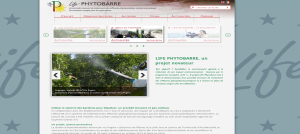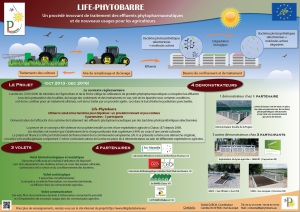What are the objectives of this component?
The objectives are to make the “Phytobarre” process known to specialists and the general public alike, and to offer the implementation of new practices to farmers.
Depending on the target, different communication measures will be conducted through dynamic, interactive and relevant media. A wide variety of communication measures will be conducted throughout these three years and directed at the following targets: farmers, local authorities, chambers of agriculture, agricultural training centers and the general public.
The website
The key tool for communicating the project is the website (https://lifephytobarre.eu/). The web pages will be enhanced throughout the project with movies, documentaries, a brochure, news, etc.
Diffusion of information to farmers and local communities
Agricultural tradeshows. The Barre Company and the experimental station “La Pugère” will present the “Phytobarre” process at agricultural tradeshows that they attend (Vinitech SIFEL, Salon International du bio et de l’Agriculture Durable (SIAD), Salon d’Automne Aquiflor, Salon Méditerranéen de la Filière Fruits et Légumes (MIFFEL), etc.).
Training materials for the agricultural sector
- Panels. Information panels will be affixed next to each demonstrator.
- A multilingual educational DVD, to be produced in 2016. It will consist of excerpts from films as well as an explanatory booklet. This product will enable the diffusion of information to educational institutions, both in Europe and internationally, as well as to local authorities.
- Visits to farms. Training on crop practices is one of the missions of the partner “La Pugère”. This innovative process will be introduced during visits to schools, agricultural high schools, local authorities and groups of farmers throughout the year. The “Louis GIRAUD” campus hosts each year hundreds of students who will represent targets for the spreading of information.
Communication aimed at scientists and experts
- Scientific publications. The results from the biotechnology component will be the subject of publications in specialized journals.
- A seminar on the management of phytopharmaceutical effluents will be organized in 2015. The participants in other LIFE projects, research organizations or private companies involved in this theme will join together to establish a network and communication measures.
- Professional tradeshows: The Barre Company will also present the process during the Pollutec tradeshow (a show for professionals working in the environment and energy). The CEA/LBC will convey information about the process during its participation in the Biomicroworld tradeshow (an international conference on environmental, industrial, and applied microbiology).
Diffusion of information to the public at large
- Films. Documentary films will be produced during the three years of the project. Two films will address the sociological aspect, before and after installation of the demonstrators. The third film will discuss the use of phytosanitary products, from the last century to today. Projections will be organized by the partner AMU/LESA.
- A televised thematic roundtable meeting with the project partners, institutional participants, users, demonstrators and potential users is planned for 2015. These participants will discuss the policy of establishing phytopharmaceutical effluent treatment plants, and the social reception linked to regulatory constraints.
- Publications. The CEA partner, through its publications (CEA Bio, CEA news, etc.), will bring value to the project on the national and international levels. The AMU partner will publish the results of the project via the Presses Universitaires de Provence.






